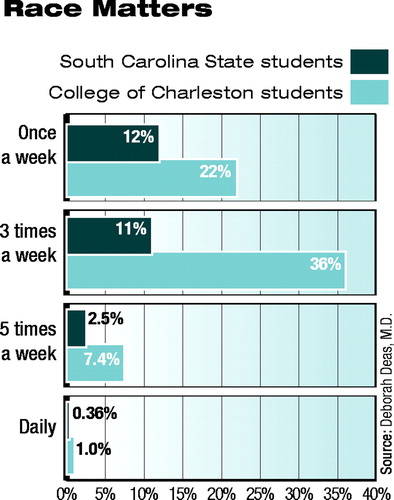Racial Differences Characterize College Drug, Alcohol Use
College officials, parents, and mental health experts who are tempted to offer sweeping conclusions about alcohol and drug use on college campuses should be careful to indicate just what campuses they are talking about now that a study has turned up some dramatic racial differences in substance use patterns.

Deborah Deas, M.D., plans to assess possible factors that might contribute to the lower rates of alcohol and drug use among the African-American students in her study.
Deas is an associate professor of psychiatry at the Medical University of South Carolina’s Charleston Alcohol Research Center. She reported her findings at the annual convention and scientific assembly of the National Medical Association in Honolulu in August.
Deas recruited about 280 student volunteers from each of the two colleges who completed the CORE Alcohol and Drug Survey. At the C of C about 90 percent of the students are white, and at SCSU about 95 percent of the students are black. The students who participated in the study were 20 years old or younger, which meant that about 80 percent at each college were in their freshmen or sophomore years.
 For marijuana use, the survey data showed that the C of C students were more likely to use the drug once a week, three times a week, or five times a week. The SCSU students, in contrast, were more likely to use the drug on a daily basis, with 4 percent of the SCSU sample and 2.9 percent of the C of C sample acknowledging daily use. The differences in the daily numbers, however, were not statistically significant.
For marijuana use, the survey data showed that the C of C students were more likely to use the drug once a week, three times a week, or five times a week. The SCSU students, in contrast, were more likely to use the drug on a daily basis, with 4 percent of the SCSU sample and 2.9 percent of the C of C sample acknowledging daily use. The differences in the daily numbers, however, were not statistically significant.
Cocaine use was extremely rare in both college populations, with none of the SCSU students and just .35 percent of the C of C students saying they used cocaine daily or weekly.
Dramatic differences appeared, however, when Deas evaluated survey responses for alcohol use.
Twelve percent of the SCSU students said they drank alcohol once a week, compared with 22 percent of the C of C students. Differences were even more stark when more frequent alcohol use was assessed. At SCSU 11 percent stated that in an average week they drank on three occasions. At the C of C, in contrast, 36 percent of the students said they drank about three times a week. In addition, just 2.5 percent of the students at SCSU admitted often drinking five times a week, while 7.4 percent of their counterparts at the C of C acknowledged the same alcohol use pattern. Deas found no statistically significant difference when she looked at the percentage of students who acknowledged daily drinking, with 1 percent of the C of C students indicating daily drinking, and .36 of the SCSU students saying they drank daily.
On average, the students at SCSU had a mean of about 1.7 drinks per week, while the C of C students imbibed about 9.5 drinks in an average week.
When it came to binge drinking, that is, having five or more drinks at a single sitting, the SCSU students again had a fraction of the alcohol use found in the C of C population.
Though 2000 data from the Monitoring the Future survey (Psychiatric News, February 1) found that 40 percent of college students nationwide admit to binge drinking, at the two colleges Deas studied, binge drinking was far less common, though the same racial patterns existed as for regular alcohol use. At SCSU, for example, 2 percent said they had engaged in binge drinking twice in the preceding two weeks, while 6 percent of C of C students said so. Further, about 4 percent of SCSU students but more than 11 percent of C of C students had engaged in binge drinking three times during that period, and 1.4 percent at SCSU and 6.3 percent at C of C acknowledged four binge-drinking episodes during that two-week period.
The comparisons of the percentages of students at the two colleges who reported that they had never used the substances in question also highlighted the problems inherent in generalizing about substance use across racial lines, Deas stated. Twenty-three percent of the SCSU students said they had never used alcohol, while 6.7 percent of the C of C students gave that response.
Similar patterns appeared for marijuana and cocaine use, with nearly 57 percent of SCSU students but just 33 percent of C of C students indicating they had never used marijuana, and 98 percent of the former and 86 percent of the latter saying they had never tried cocaine. All of these differences were statistically significant, Deas noted.
Deas added that she also surveyed a sample of the few African-American students at the C of C and noted that while the numbers were small, their alcohol and drug use did not differ from the patterns found among the African-American students at SCSU.
She plans to conduct research to assess possible protective factors—religiosity, parents’ income level, or students’ perceptions about available support systems, for example—that might account for the lower rates of alcohol and drug use among the African-American students in her study. ▪



